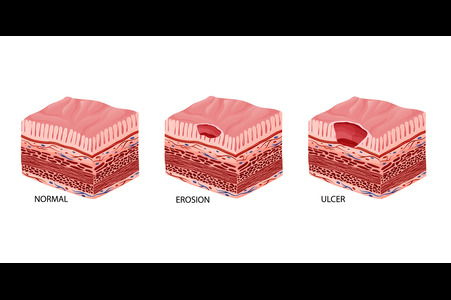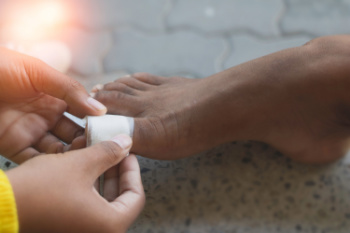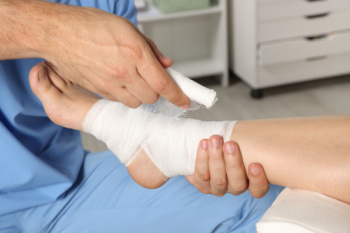
Pressure injuries on the lower legs and feet form when skin and tissue are damaged by continuous pressure, friction, or shear. These injuries are frequently seen on heels, ankles, and the sides of the feet where bones lie close to the surface. People who are less mobile, have diabetes, or suffer from vascular disease face higher risks, as their skin is often more fragile and slower to heal. These wounds can begin as mild discoloration or swelling, but may progress to deep open ulcers if not treated promptly. Management often includes specialized dressings, relief of pressure with cushions or footwear modifications, and improved circulation through medical care. Preventive strategies involve daily skin inspections, proper support surfaces, and attention to nutrition. If you suspect a pressure injury on your lower extremities, it is suggested that you see a wound care specialist.
Pressure Sores, Pressure Ulcers, and Arterial Ulcers Can Lead to Skin Breakdown
Not all wounds on the feet, ankles, and legs are the same. Pressure sores, pressure ulcers, and arterial ulcers may look similar at first, but develop for different reasons and require specialized care. Understanding these differences is key to proper treatment.
Pressure sores are often caused by friction at common rubbing points. Toes rubbing against each other can create small raw areas, while wearing ill-fitting shoes may lead to sores on the heel, ankle, or sides of the foot. These injuries usually begin at the surface but can quickly deepen if ignored.
Pressure ulcers, sometimes called bedsores, occur when the skin and tissue are compressed between bone and an external surface for long periods of time. On the lower extremities, they frequently appear on the heels, ankles, calves, or shins. Limited mobility, tight footwear, or prolonged bed rest can all contribute to these ulcers, which may progress through multiple stages from redness to open, infected wounds.
Arterial ulcers are different in that they result from poor circulation. When blood flow to the feet and legs is reduced, oxygen and nutrients cannot reach the tissue. Even small sores on the toes, heels, or shins may become painful, deep ulcers that heal very slowly. Unlike friction-related sores, arterial ulcers are directly tied to vascular health and often signal an underlying circulation problem.
All three types of wounds demand professional attention. A wound care specialist can determine the cause, relieve pressure, improve circulation when possible, and use advanced techniques to promote healing.
If you notice a sore on your foot, ankle, or leg that is slow to close or worsening, call us for timely care to help prevent serious complications and preserve long-term mobility.

Blisters on the legs or feet may seem minor, but when caused by friction, wearing poor footwear, or circulation issues, they can quickly become painful and difficult to heal. People who walk long distances, wear tight shoes, or have medical conditions such as diabetes or vein disease are more likely to experience these fluid-filled bumps. A wound care specialist evaluates the cause and condition of the blister to determine the best treatment. This may include gentle drainage under sterile conditions, application of advanced dressings, and steps to reduce pressure or friction. If an infection develops, topical or oral medications may be needed. Preventive care includes keeping skin dry, wearing well-fitting shoes, and inspecting the legs and feet regularly. If a blister does not heal or becomes red and sore, it is suggested that you schedule an appointment to see a wound care specialist.
Why Blisters Can Be Risky for Leg and Foot Health
Blisters are small pockets of fluid that form beneath the skin, often as a result of friction, pressure, or burns. On the feet, ankles, and legs, they are particularly common because these areas endure daily stress from walking, running, and wearing shoes. While many blisters are minor, they can become serious if not treated correctly, especially in individuals with diabetes or poor circulation.
Friction is the most common cause of blisters. Shoes that are too tight, too loose, or not properly cushioned may rub against the heel, toes, or sides of the foot, leading to painful fluid-filled bubbles. Activities such as hiking, sports, or even long periods of standing can also trigger blisters, especially when combined with moisture from sweat.
Other blisters may form from burns, allergic reactions, or underlying medical conditions. On the lower extremities, blisters that break open expose the skin to bacteria, increasing the risk of infection and complicating the healing process. If a blister appears on the ankle, heel, or shin, it may interfere with walking and daily mobility.
Proper care begins with protecting the blister. Keeping the area clean, covered, and free from further friction supports healing. However, large, painful, or recurrent blisters often require professional evaluation. For patients with compromised circulation or nerve damage, even a small blister can turn into a much larger problem if ignored.
A wound care specialist can determine the cause, provide safe drainage if needed, and apply advanced dressings to promote recovery. They can also recommend changes in footwear, activity, or skin protection strategies to prevent future blisters.
If you have developed a blister on your foot, ankle, or leg that is not healing or is becoming more painful, make an appointment with us as soon as possible.

Cuts and grazes on the feet, ankles, and lower legs are common, but should not be ignored. These areas are prone to injury from shoes, sports, or even small accidents around the home. Because the skin on the lower limbs is closer to the ground, wounds here are at greater risk of contamination and infection. Proper care is vital to promote healing and prevent complications. Start by gently washing the area with mild soap and water, then apply a sterile dressing to keep the wound clean and protected. Keep an eye out for warning signs such as increasing pain, redness, or pus. If you have poor circulation, diabetes, or slow-healing skin, even minor cuts should be taken seriously. It is suggested that you see a wound care specialist to ensure the injury heals properly and to avoid long-term problems.
Wounds on the feet, ankles, and legs require special attention because these areas are extremely vulnerable to infection and slower healing. Even a small scrape or cut can become more serious if not treated promptly, particularly for individuals with diabetes, poor circulation, or weakened immune systems.
Abrasions occur when the skin is rubbed or scraped against a rough surface, often leaving raw, painful patches that expose delicate tissue. On the feet and legs, these are more susceptible to contamination from shoes, socks, and daily activities. Cuts and scrapes that break through deeper layers of the skin create open wounds that may bleed and require proper cleaning and covering to reduce risk of infection.
Some injuries are more complex. Traumatic wounds, such as lacerations caused by accidents or falls, can damage not only the skin but also the underlying structures of the foot or ankle. Puncture wounds from sharp objects are another concern, as they are often narrow and deep, allowing bacteria to become trapped inside. These injuries may not look severe on the surface, but can result in serious infection if not evaluated by a wound specialist.
Because the lower extremities play such a vital role in mobility, untreated wounds in this region can interfere with daily activities, and, in severe cases, threaten long-term health. Proper wound care includes cleaning, dressing, and monitoring the injury, and in some cases, advanced treatment to close or debride the wound and support faster healing.
If you have a cut, abrasion, or puncture wound on your foot, ankle, or leg that is not improving or appears infected, call us for help today. Prompt treatment ensures effective healing and helps protect your mobility and overall health.

Custom orthotics can be used to relieve foot pain and discomfort. They're also used to treat various foot conditions and deformities. Flat feet, bunions, and Morton's neuroma are just a few of the foot conditions that have been known to benefit from the use of orthotics.
Comfy feet are happy feet! Contact us today.
